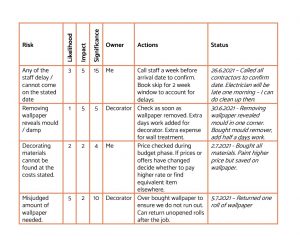Project management expertise is not solely reserved for Project Managers; most of your team will likely need to draw on effective Project Management skills in the course of their role. Of course, they want to do the best possible job in everything they do, and your organisation benefits hugely from their motivation. You can support them in their mission by showing them this 5-part blog series, delving in to the fundamentals of Project Management for self-leaders.
If you missed the previous instalment, “Time management”, you’ll want to hop back there to give your learning journey the strongest foundations. Already been there? Excellent, in this instalment, you’ll discover how to manage and mitigate risk for outstanding project performance.
Many projects do not run exactly to plan because there are so many variables to keep track of. Anticipating these risks is the first step to managing them quickly and reducing the impact on the project.
Begin by brainstorming all of the things that could go wrong. This will form the basis of your ‘risk log’. Once you have identified each item, complete the following:
In a house-building project the risk analysis may look something like this:

These questions allow you to prepare in advance of the project. The status column would be filled out during the project as part of the monitoring process. The risk items with the highest significance need monitoring the most closely.
Note: Smaller projects may have fewer risks to consider, but those risks may have a larger impact on the project because there are less tasks to be completed in parallel, meaning a smaller amount of buffer.
After mapping out your goals, resources and tasks for your project you’re going to need to apply 3 essential processes to refine your project plan and mitigate risks.
It can be tempting to work with “the average” for your estimations when planning your project. For example, the average staff member could complete this in a day and a half, or the average cost of printer toner is £75.
The risk here that you need to mitigate is that there is a 50% chance that you will be under cost and a 50% chance that you will be over cost. If you are over cost on a number of items in your project, then you will quickly find yourself having to adapt the project parameters or go back to the stakeholders to request a bigger budget – neither of which are ideal scenarios.
Instead, and in order to mitigate risk, it is better to work at a margin of error around 75%. This means thinking about the space between the average and the worst case:
Average worker 1.5 days > Worst case 5 days = estimate of 3 days
Average toner £75 > Worst case £120 = estimate of £95
This way of estimating builds in some contingencies for later down the line. The 75% rule helps you to reduce risk and protect your project. It’s helpful to build in contingency figures for costs in order to manage any risks or delays further down the line. These contingencies are:
Each project may need a different type of contingency based on where you feel the biggest risks to budget are. When costing a professional project, remember you may need to add in your wages / fees as the project manager – as these can sometimes be overlooked.
The critical path, or the network path, is the name for the longest chain of tasks that have to be done in a set order. Floating tasks do not directly affect the main bulk of the project, but may have to be completed before certain milestones. Some side or sub tasks may directly impact others. In a larger project, graphic design work may need to take place before a communication launch, even though it may be a side task.
Understanding the critical path can help to mitigate risks and slippages in your project. Your team can use their time management skills to ensure that those critical tasks are always being prioritised and that you plan for any bottlenecks in advance.
Constant monitoring of your project is essential to its success. Deciding during the planning stage on how you will keep track of progress will help to manage risks. You’ll need to decide how often you will:
As a project manager you have to evaluate possible actions against the impact they would have on your project’s constraints. Having a firm grasp of which of the constraints (time, cost, scope) are the most important when delivering the project will help you to make effective risk mitigating decisions.
Risks are an inevitable element of Project Management. This is why positive relationships within the team are essential for project success. Powerful self-leaders inspire high levels of trust, accountability and rapport. This creates a safe space for team members to honestly share their successes and concerns / challenges over the course of the project. The earlier people are able to inform the project manager of a deviation from the plan (whether positive or negative) then the easier it will be for the project manager to minimise the risks involved.
Feedback and evaluation are essential to monitoring projects and successful future projects. That’s why, in the next and final instalment of this series, you’ll be diving in to project feedback and evaluation. The final blog post in this series will be published on 3rd August. Whilst you’re waiting, you might be interested in these blog posts looking at developing a growth mindset, failure as a necessary learning curve and how coaching can help.
If you’re already itching to get started and unlock the Project Management potential and power of your team, The Self Leadership Initiative is here for you. Book in a FREE 30 minute chat with Founder Gemma Perkins to discuss your team’s needs today.